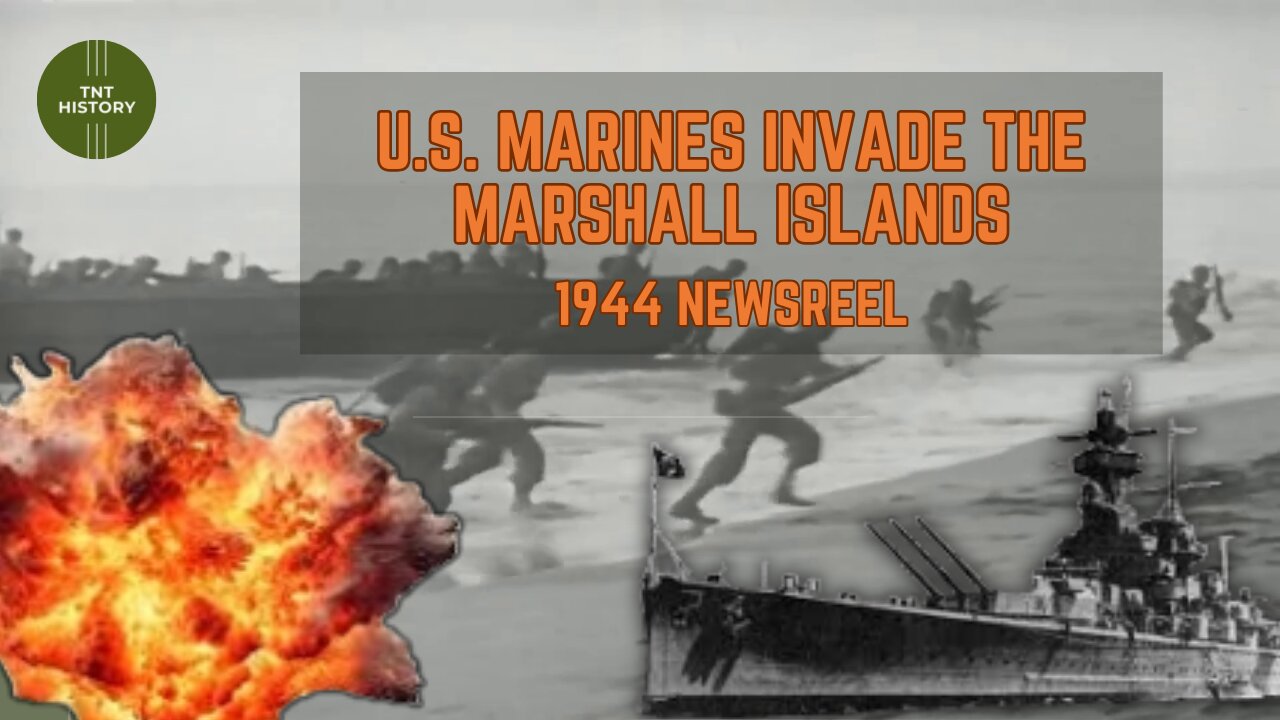Premium Only Content

Unleashing Fury: US Marines Conquer the Pacific - Marshall Islands WWII Campaign
►Twitter /X : https://twitter.com/history_tnt
During World War II's Pacific Theater, the Marshall Islands Campaign (January - February 1944) emerged as a pivotal strategic initiative led by the United States Pacific Fleet and Marine Corps. Situated as the outer perimeter of eastern defenses for the Japanese Empire, the Marshall Islands housed critical bases targeted by the Allies. The primary objective of the campaign was to establish airfields that could provide essential land-based air support for upcoming Allied operations across the Central Pacific. This battle, integral to the Pacific War, was documented under fire by combat photographers for newsreels.
Historically, the Marshalls, located east of the Caroline Islands in the western Pacific Ocean, had been under Japanese control since World War I. Occupied in 1914 and designated as part of the "Japanese Mandated Islands" by the League of Nations, the islands were included in the Treaty of Versailles after World War I, ceding certain German-controlled islands, including the Marshalls, Carolines, and Marianas (except Guam), to Japan. However, Japan withdrew from the League in 1933, subsequently transforming the Mandated Islands into military bases, restricting access to non-Japanese individuals, including Christian missionaries.
As World War II unfolded, these islands became Allied targets, with the U.S. Central Pacific Campaign commencing with the Gilbert Islands in November 1943. Operation Flintlock followed, focusing on capturing the Marshall Islands. Applying lessons learned from the Battle of Tarawa, the U.S. executed a successful twin assault led by Admiral Raymond Spruance. On January 22, 1944, the 5th Fleet landed 53,000 assault troops on the islets of Roi and Namur in the north, while American planes, based in the Gilberts, bombarded the Japanese administrative center on Kwajalein, a southern atoll within the Marshall cluster.
By January 31, Kwajalein was heavily damaged, and U.S. forces had eradicated all Japanese airplanes on the Marshalls. By February 3, U.S. marines overcame staunch Japanese resistance to capture Roi and Namur atolls. Despite being outnumbered and underprepared, the Japanese defenders on Roi-Namur dwindled to 51 survivors from an original garrison of 3,500. With the loss of only 400 American lives, the Marshalls fell into American hands.
For the U.S., this victory marked progress in the island-hopping strategy toward Japan and a significant moral triumph as the Americans breached the "outer ring" of the Japanese Pacific sphere. Conversely, for the Japanese, the battle signified the failure of beach-line defense strategies, leading them to fortify defenses in depth. Subsequent battles at Peleliu, Guam, and the Marianas proved more costly for the U.S. as Japan adapted its defensive tactics.
●Visit Jadesales.shop for Reliable and Affordable Products - Free Shipping on Orders over $45
►Electronics: https://bit.ly/Electronic-Collection
►Health Products: https://bit.ly/Health-Items
►School Supplies: https://bit.ly/Jade-Sales-School-Supplies
#MarshallIslands #USMarines #WWII
-
 5:06:15
5:06:15
AirCondaTv Gaming
15 hours ago $31.48 earnedOnce Human - New Year. New Meta. Happy New Year!
109K14 -
 1:00:37
1:00:37
Bright Insight
10 days agoOlmec Heads are Evidence of Lost Ancient Advanced Civilization
126K229 -
 13:43
13:43
Cooking with Gruel
2 days agoCreamy Saffron Risotto
103K20 -
 18:38
18:38
DeVory Darkins
1 day ago $25.25 earnedTrump Makes HUGE Announcement that may spark GOP Battle
84.2K82 -
 2:13:05
2:13:05
The Nerd Realm
14 hours ago $5.58 earnedNew Years Eve! Fortnite Hunters w/ YOU! Creator Code: NERDREALM
68.4K5 -
 11:04:44
11:04:44
FusedAegisTV
1 day agoNYE Eve! - 2025 Incoming 🎉 - 12hr Variety Stream!
133K7 -
 1:18:52
1:18:52
Awaken With JP
17 hours agoSomehow The World DIDN’T End This Year! - LIES Ep 72
167K89 -
 1:19:34
1:19:34
Michael Franzese
15 hours agoWhat 2024 Taught Us About the Future?
133K32 -
 1:48:09
1:48:09
The Quartering
15 hours agoBird Flu PANIC, Sam Hyde DESTROYS Elon Musk & Patrick Bet David & Woke Witcher?
139K78 -
 4:47
4:47
SLS - Street League Skateboarding
3 days agoLiz Akama’s 2nd Place Finish at SLS Tokyo 2024 | Best Tricks
61.7K6